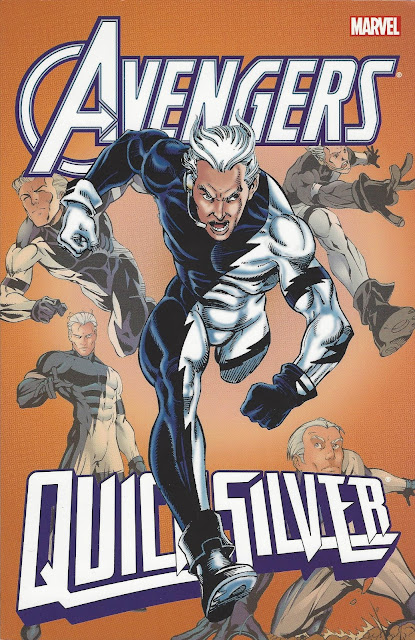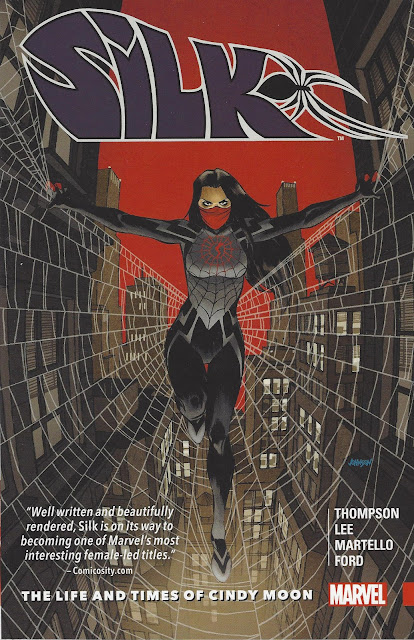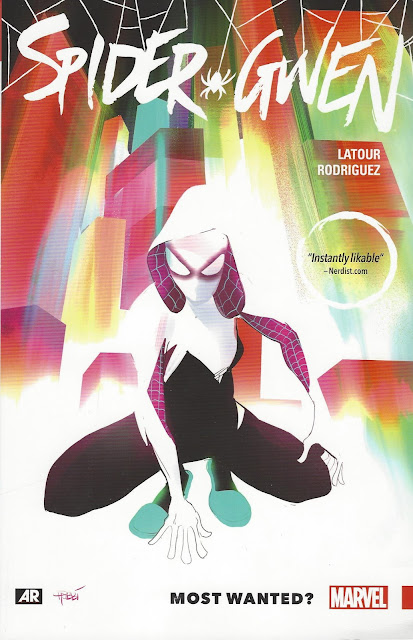Avengers: Quicksilver
Collects: Quicksilver #1-13, Heroes for Hire #15-6, and Heroes for Hire / Quicksilver Annual ‘98 (1997-8)
Released: March 2015 (Marvel)
Format: 440 pages / color / $34.99 / ISBN: 9780785192930
What is this?: With the Avengers gone, Quicksilver becomes leader of the Knights of Wundagore. Sure, why not?
The culprits: Writers Tom Peyer, Jon Ostrander, and Joe Edkin and pencilers Derec Aucoin, Paschal Ferry, Ivan Reis, Casey Jones, and others
I wouldn’t say Quicksilver is one of Marvel’s most fascinating characters, but he does have several facets that are worth examining. Pietro Maximoff is the biological son of Magneto, the mutant rights crusader / supremacist / messiah; how does he deal with the implications and obligations of that? How does who his father is affect his relationship with his daughter, Luna? He’s married to Crystal, a member of the Inhuman royal family; how does he get along with his in-laws? Why does he have occasional bouts of insanity, and does he want to do anything about it? How does he feel about the various groups he’s been with, like X-Factor, the Avengers, and the Brotherhood of Mutants? Is he truly a hero, given his heel turns? And what’s his relationship with his sister like?
Well, in 1997, with the Avengers (including his wife and sister) trapped in a different universe after Onslaught, Marvel decided to give Quicksilver his own series, which has been reprinted in Avengers: Quicksilver. As you no doubt have not guessed, the focus of the series was on Pietro and his leadership of the Knights of Wundagore.
 Yes, the Knights of Wundagore, a bunch of animals who have been uplifted by the High Evolutionary to be human-like and taught to treasure the values of chivalry. Why wouldn’t you want a series about them?
Yes, the Knights of Wundagore, a bunch of animals who have been uplifted by the High Evolutionary to be human-like and taught to treasure the values of chivalry. Why wouldn’t you want a series about them?Perhaps because you don’t like being bored. That’s the reason I would’ve voted against making them the primary supporting characters of the series. Quicksilver’s connection to the Knights is that another of the High Evolutionary’s creations, Bova, was midwife to his and his sister’s birth. Bova then gave them both to a gypsy couple because the Evolutionary told Bova he sure as hell wasn’t raising them.
With no team to join, Pietro has retreated with his daughter to Wundagore, which quickly falls to an assault by the Acolytes, a mutant band who worships Magneto. The High Evolutionary leaves and puts Pietro in charge of the Knights, which is a bad idea. Quicksilver’s personality is mercurial (ha!), and he rarely sticks with anything for long. Perhaps as someone who has been abandoned, Quicksilver might be expected to cleave to the Knights, but instead he wanders off, doing other things. It’s not so much that Pietro is a bad leader; it’s that he’s rarely around to lead. Most of the Knights are captured by the Brotherhood of Mutants for three issues before Pietro notices. When the main character of a series can’t be bothered to show any interest in the plot, the series is in definite trouble.
Initial writer Tom Peyer introduced a large cast: Pietro, the Knights, the Acolytes. The Knights’ personalities — except for White Tiger, who appears mainly in Heroes for Hire — are too human, too archetypal. They are loyal servants of the High Evolutionary, loyal brothers and sisters to each other, and little distinguishes them from one another. A couple are brainy, a couple are earthy, but only their animalian appearances make them stand out. Sometimes, not even that makes them seem any different: when the Knights visit New York, the crowds’ reactions are little different than when the X-Men, with their image inducers on, take in a Broadway show. As for the villains, none of the Acolytes develops a distinct personality except for Exodus (zealous madman) and Amelia Voght (underling whose heart might not be in the cause). The rest don’t even rate an archetype.
Peyer also includes a few issues with the Inhuman royal family after Crystal returns from Heroes Reborn. Thematically, he hits the right notes in this story: Pietro feels like an outsider among the Inhumans, and he feels they are suspicious of him because of his previous poor choices in their kingdom. It’s also the only place in the book we see Quicksilver’s impatience with the slow pace of human (or Inhuman) life. Maximus, the evil member of the royal family, takes advantage of Pietro’s reputation and impetuousness, but the Inhumans who jailed him for what he did under Maximus’s control get off too lightly — especially given how Maximus exploited them as well. (There’s also the matter of the Inhumans’ slave race, but that’s not really relevant.)
Peyer leaves after #6, after the dust-up with the Inhumans is over. The new writers, Jon Ostrander and Joe Edkin, write Crystal out immediately. The separation between Pietro and Crystal happens not because she doesn’t like the Knights (she doesn’t, but they barely enter into the story at this point) or because of her family’s distrust of Pietro; it’s because he acts like a controlling, jealous husband whenever the man Crystal had an affair with, the Black Knight, is around. It’s not hard to understand why Pietro would act that way, but it’s an additional complication that isn’t necessary.
Ostrander and Edkin turn the book into a Knights vs. Acolytes story, with Exodus using the Brotherhood of Mutants as patsies. This story meanders from upstate New York to the Savage Land and back before heading to Wundagore Mountain. None of the action leading up to the series-ending crossover, Siege of Wundagore, makes much of an impression. The High Evolutionary is having trouble with his form and mind, but the story would drift toward the same conclusion with or without him. The death of one of the Knights makes a brief ripple in the story’s aimlessness, but the Knights aren’t that bothered themselves about it.
It’s a shame, really. During these issues, it becomes obvious who Sir Anon, a Knight who hides his identity, is. The Knights’ blind loyalty to the High Evolutionary and their brotherhood keeps them from seeing it, however. Sir Anon should be important during these issues, but he’s playing the waiting game; rather than nudging the pieces into the right places, Sir Anon waits for them to drift together, then acts during the Siege of Wundagore crossover.
The Heroes for Hire seem tacked onto the Siege of Wundagore, a crossover that tried to revive interest in two titles lurching toward cancellation. Only White Tiger was needed, since she’s one of the Knights, created by the High Evolutionary to fight his wayward creation, the Man-Beast. Another Hero might be interesting; White Tiger loves Iron Fist, and Black Knight’s history with Pietro might complicate matters. But those three plus Luke Cage and Ant-Man bog down the story, and their fight for their humanity after the High Evolutionary “evolves” them never gets the space it needs to be interesting.
So: the bottom line is that the entire book is too overcrowded with characters that never get developed, with faces indistinguishable from the crowd. Quicksilver’s involvement in the Live Kree or Die crossover (#10, part 3 of 4) with various Avenger-related titles makes matters even worse, and that’s not even considering the After-School Special tone of the issue.
None of this helps the book’s many artists any. Derec Aucoin, who penciled #4-6, 8, 10, and parts of 11 and 12, tries his best, but it’s all forgettable. He and the other artists, who include Pascal Ferry (Heroes for Hire and the annual), Ivan Reis (#7 and 9), Casey Jones (parts of #1-3), blend into a flavorless mélange of ‘90s art. (Mark Bagley makes an incongruous but recognizable appearance in #3.) None of them are incompetent, although their rendering of the female form might be criticized. Their action sequences are largely understandable. Their body language makes sense, usually. It’s just … it was the ‘90s, man, and a second- or third-tier title at that. Expectations weren’t high, but they were met, and possibly slightly exceeded.
Avengers: Quicksilver was almost certainly published in anticipation of Quicksilver’s appearance in Avengers: Age of Ultron. I can’t imagine this book did the character any favors, and like the original series, it’s publication is a lost opportunity to do something more interesting.
Rating:
 (1.5 of 5)
(1.5 of 5)Labels: 1.5, 2015 March, Casey Jones, Derec Aucoin, High Evolutionary, Ivan Reis, Joe Edkin, Jon Ostrander, Marvel, Paschal Ferry, Quicksilver, Savage Land, Tom Peyer, Wundagore Mountain







